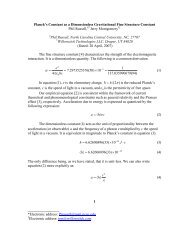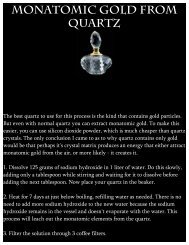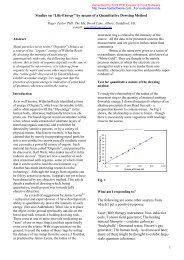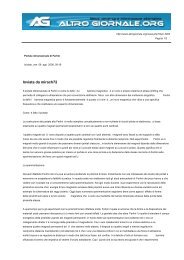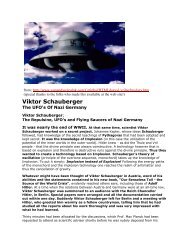Superconducting Elements from Grape Juice
Superconducting Elements from Grape Juice
Superconducting Elements from Grape Juice
- No tags were found...
You also want an ePaper? Increase the reach of your titles
YUMPU automatically turns print PDFs into web optimized ePapers that Google loves.
<strong>Superconducting</strong><br />
<strong>Elements</strong> <strong>from</strong> <strong>Grape</strong><br />
<strong>Juice</strong><br />
Little does the modern technological world know, room temperature<br />
superconductors can be purchased at your local grocery store; and for a very<br />
low price.<br />
<strong>Grape</strong> <strong>Juice</strong> for some reason contains a high concentration of superconducting<br />
monatomic elements. There is enough present in one can of frozen juice to be<br />
easily separated with a magnet. We know this isn't iron because it would<br />
indicate that level of iron on the label. So the only thing left is monatomic<br />
elements. This fits well with David Hudson's information about grapes<br />
containing large amounts of m-iridium and m-rhodium. But our bodies don't<br />
gain access to these elements because of the high levels of sugar in grapes.
This process below breaks down the sugar using sodium hydroxide, releasing<br />
the m-state elements which can then be separated using a magnet. The<br />
magnet charges up the monatomic elements and makes them become<br />
superconductive which is why they are attracted to the magnet. In their<br />
natural form, they are locked inside the sugars in the grapes and can't be<br />
charged with a magnet, and this is why it does no good to place a magnet next<br />
to grape juice then drink it. But when dried and extracted, they can be fully<br />
charged, then ingested, and the effect is quite powerful in large doses.<br />
1. In a 250ml pyrex beaker, put 100ml of frozen Concord grape juice in it,<br />
then fill to 200ml with water.<br />
2. Add some lye to adjust the pH to 14, and slowly bring the juice to a boil.<br />
Turn down the heat when the boiling starts to cause the juice to overflow.<br />
3. Let it boil lightly for 6 hours or a little longer, until the water has<br />
evaporated and your left with a hard black crust.<br />
4. Now crush and pulverize this black crust in a plastic bowl until it's a fine<br />
powder. Run a magnet over it, and you will see the magnetic material jump<br />
around. Put a piece of paper over the magnetic so you can collect anything<br />
that sticks to it. If this doesn't happen it's because you didn't heat the powder<br />
up hot enough when you dried it. You need to heat the powder up to a higher<br />
temperature to anneal it, then let it cool off. A candle flame provides a<br />
sufficient temperature.<br />
Discovered by Adam aka "Wizard"



